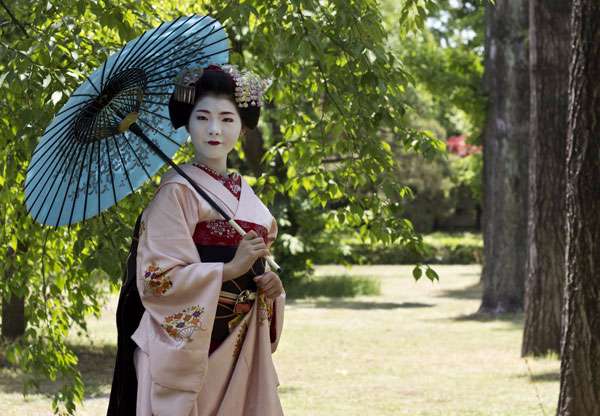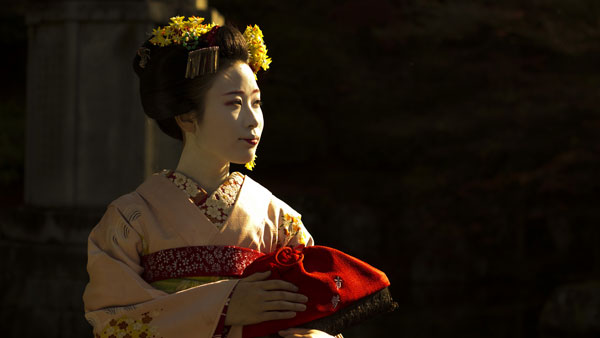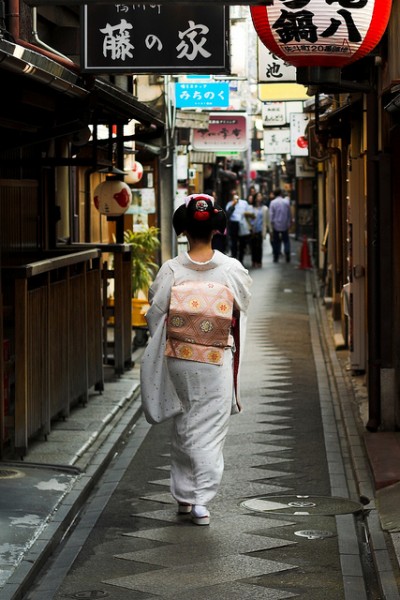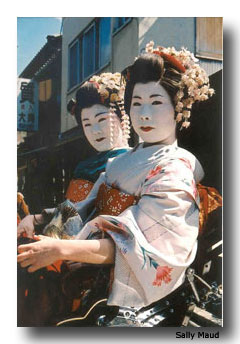

All About Geisha
Imagine a job ad that read like this: “Wanted: disciplined, hardworking 15-year-old who is not afraid of constant study and training, late nights and early mornings.
Should be able to sing, dance, engage in hours of demure conversation and drinking games all while wearing elaborate, restrictive costumes.”
It sounds bizarre, but this is exactly what young Japanese women have been signing up to become for centuries when they enter the world of the geisha.
The novel Memoirs of a Geisha, Puccini’s tragic opera Madame Butterfly and countless movie references have provided the curious West with various views of what life as a geisha is like.
But for those interested in getting beyond the fictional images, the best view of this intriguing profession is found in the geisha district of Gion in the ancient city of Kyoto.

A visitor strolling the cobbled lanes and alleyways of Gion without an informative and enthusiastic guide would miss the hidden clues and subtle hints that reveal this extraordinary way of life.
“Geisha, Past, Present and Future”
Luckily for English-speaking visitors to Kyoto, Peter MacIntosh, a knowledgeable historian and a Kyoto resident, has offers walking lecturers of Gion titled “Geisha, Past, Present and Future.”
Peter’s understanding and respect for this fascinating world is based not just on history books and research, but also on his time spent as both a friend and confidante of these unique women.
The story of geishas starts in the early 1700s when the first male geisha appeared in the walled-in pleasure quarters of Tokyo and Kyoto.
It was within these designated entertainment precincts that the chronin (merchants) spent their time and money cultivating the arts.
The First Female Geishas
The first female geishas appeared soon after, and while the assumption is that they were a mixture of courtesan, prostitute and entertainer, their role was always designed to complement the courtesans, not compete with them.
That role has changed little over the centuries. Geishas are still very much professional entertainers. Even after their initial apprenticeship, they continue to train in their arts of music, dance and singing.
Their disciplined life and dedication is not unlike that of a professional dancer.
Most Significant Professional Entertainers
Nor are geishas simply legal prostitutes, as often portrayed in Western literature and film. Geishas keep the Japanese arts alive with their traditional kimonos, dance and music, and they are still admired for their role in society.

After the courtesans peaked in popularity in the mid 18th century, it was the artistic geishas, with their talents in dance, music and song.
Then it became the most significant professional entertainers in Japan’s pleasure quarters.
With these words of the geishas’ history still ringing in our ears, we follow Peter along the streets of Gion. Our guide pauses to point out the simple wooden name plaques adorning the entrance to a traditional ochaya (teahouse).
The relationship between the mistress of the teahouse and the geisha has not changed over the centuries. The geishas entertain their clients within the tranquility of these establishments.
The exclusiveness of this relationship is symbolized by the geishas’ name plaques appearing at the entrance of the chosen teahouse where they serve.
Kimono Dresser
As I run my eyes of the names, an inconspicuous man suddenly whirls past on a bicycle, obviously in a hurry. “He’s a kimono dresser,” explains Peter.
The “dresser” is a trusted position passed down through the generations from father to son. Clipped to bicyclist’s key chain are approximately 20 house keys of his geisha clients whom he visits daily to help them dress in their elaborate kimonos.
These skilled dressers can fold, tuck and tie what seems like miles of embroidered silk into a glorious vision in less than six minutes.
This is an impressive feat considering my own kimono-wearing exploits took three accomplished women more than 20 minutes to complete.
As we stroll pass the elegant paneled okiya (boarding houses) where the geishas reside, two doll-like creatures float past in their colorful kimonos.
Who Are the Maikos
The woman are not geishas, but the apprentice maikos whom we learn from Peter can be distinguished by the style of their hair, the ornaments adorning their hair and the color of the cloth appearing at the collar of their dress.
Maikos are allowed to put lipstick just on the bottom part of their lips while geishas can put it on both of their lips.
This distinctive dress can also denote the year of the maiko’s apprenticeship, one that lasts five years with additional “post-apprentice years” before a geisha starts to earn an income.
The apprenticeships usually start when the girls are 15, after they have graduated from junior high school.
As an English teacher in a Japanese junior high school, it’s hard for me to imagine my own giggling, energetic students as these demure, poised maikos.
And as their teacher, I think I would be happier if my students remained content to simply play “dress up”, rather than the real-life version of this profession. At various salons in Gion, young Japanese girls can enjoy being clothed in the beautiful kimonos.
They have their hair and make-up done in the geisha style before hitting the streets to enjoy being photographed and gazed upon by curious visitors who mistake these girls for the real thing.
When They Retire
Retirement for geishas comes at their choosing or upon marriage. It could be a wealthy client who eventually captures her heart; geishas are definitely free to marry for love.
But while marriage will bring an end to their career as geishas, divorced former geishas are known to return to the profession once they are single again.
As we continue our stroll through Gion, Peter points out the simple, non-descript storage buildings at the rear of the boarding houses. Kimonos are stored here, carefully folded and boxed, and kept away from threat of fire.
Special Kimonos for Geishas
Custom dictates that geishas wear a different kimono each month of the year, usually in a style and design that reflects the season, with additional ones required for special performances and ceremonies as they graduate from being a maiko to a geisha.
The large number required and the sheer expense of each kimono prohibits the geishas from directly owning them. This privilege – and expense – usually rests with the mistress of the boarding house.
In addition to the collection of kimonos, the mistress is responsible for the training and preparation of the maikos during their apprenticeship.
This includes not only their living expenses, but their lessons in dance, shamisen (Japanese harp) and singing that they complete at a nearby academy.
The estimated cost for the five-year apprenticeship is US$500,000. This may explain why the number of registered geishas in Kyoto is now just 223, less than a fifth of the numbers during the peak of the profession in this area in the early 1900s.

By comparison, many Japanese women still have few opportunities and choices when it comes to career and lifestyle.
A woman working in the corporate sector is referred to condescendingly as “an office lady.” If she marries and has a family, her husband may work 16 to 18 hours a day, forcing the wife and mother to become pretty much a single parent, isolated at home.
How Much They Earn
Geishas can make between US$10,000US and $12,000 a month, and they receive a level of respect that few other roles for Japanese women attain.
So while becoming a geisha may seem a traditional and old-fashioned career choice, in some ways it offers Japanese women more freedom than other careers and lifestyle choices.
The commentary that fascinated me most on our walking tour was not the past of Gion, but the continued fascination with geishas in modern Japanese society.
The intricate process that is required to receive the appropriate introductions to a teahouse (the agents for the geishas), the exorbitant expense — with payments being made to the various layers of the geisha hierarchy.
In return for a simple evening’s entertainment of drinking, music and conversation — seem out of step with the instant and ready access to entertainment that modern Japanese have come to expect.
As we near the end of Peter’s tour, I find myself struggling to find any connection with these women. Their lives, their customs and attitudes seem so removed from those of both modern Japanese and Western women.
Yet there is an element of “businesswoman savvy” lurking under their mask-like makeup.
Geisha Business Cards
As we stop at a small shrine, we’re surprised by the volume of stickers, printed in Japanese characters, adorning the lamp and walls of the shrine.
No, it’s not some strange type of offering to the shrine, but geisha “business cards.” This, in turn, prompts Peter to open his wallet and display a similar selection covering the inside covers.
His geisha friends have encouraged him to place them there, he says, to bring him good luck and good fortune.
Well, maybe the Japanese guys will fall for this one, but our genial guide laughs.
He knows this is really just the women’s subtle reminder to call and reserve another evening of entertainment. Everyone is into marketing, it seems, even in ancient Kyoto.
- Cruising with Discovery Princess on the Mexican Riviera - March 30, 2024
- La Paz, Mexico: Pearl on the Sea of Cortez - February 26, 2024
- 9 Places to Experience Amazing Sea Life Up Close - January 26, 2024
